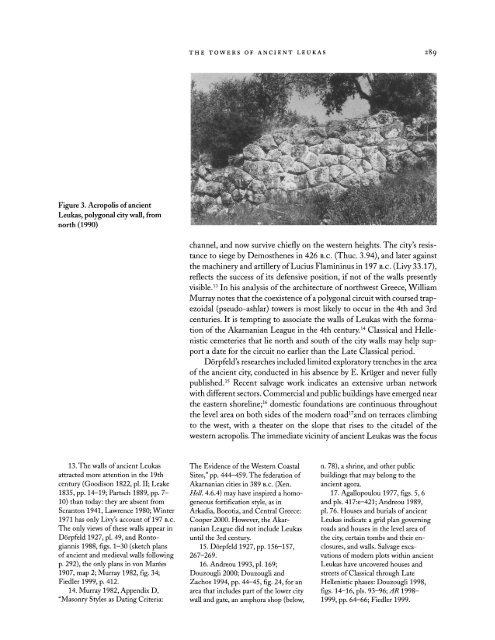the towers of ancient leukas - The American School of Classical ...
the towers of ancient leukas - The American School of Classical ...
the towers of ancient leukas - The American School of Classical ...
Create successful ePaper yourself
Turn your PDF publications into a flip-book with our unique Google optimized e-Paper software.
THE TOWERS OF ANCIENT LEUKAS<br />
289<br />
Figure 3. Acropolis <strong>of</strong> <strong>ancient</strong><br />
Leukas, polygonal city wall, from<br />
north (1990)<br />
channel, and now survive chiefly on <strong>the</strong> western heights. <strong>The</strong> city's resistance<br />
to siege by Demos<strong>the</strong>nes in 426 B.C. (Thuc. 3.94), and later against<br />
<strong>the</strong> machinery and artillery <strong>of</strong> Lucius Flamininus in 197 B.C. (Livy 33.17),<br />
reflects <strong>the</strong> success <strong>of</strong> its defensive position, if not <strong>of</strong> <strong>the</strong> walls presently<br />
visible.13 In his analysis <strong>of</strong> <strong>the</strong> architecture <strong>of</strong> northwest Greece, William<br />
Murray notes that <strong>the</strong> coexistence <strong>of</strong> a polygonal circuit with coursed trapezoidal<br />
(pseudo-ashlar) <strong>towers</strong> is most likely to occur in <strong>the</strong> 4th and 3rd<br />
centuries. It is tempting to associate <strong>the</strong> walls <strong>of</strong> Leukas with <strong>the</strong> formation<br />
<strong>of</strong> <strong>the</strong> Akarnanian League in <strong>the</strong> 4th century.l4 <strong>Classical</strong> and Hellenistic<br />
cemeteries that lie north and south <strong>of</strong> <strong>the</strong> city walls may help support<br />
a date for <strong>the</strong> circuit no earlier than <strong>the</strong> Late <strong>Classical</strong> period.<br />
Dorpfeld's researches included limited exploratory trenches in <strong>the</strong> area<br />
<strong>of</strong> <strong>the</strong> <strong>ancient</strong> city, conducted in his absence by E. Kriger and never fully<br />
published.15 Recent salvage work indicates an extensive urban network<br />
with different sectors. Commercial and public buildings have emerged near<br />
<strong>the</strong> eastern shoreline;16 domestic foundations are continuous throughout<br />
<strong>the</strong> level area on both sides <strong>of</strong> <strong>the</strong> modern road17and on terraces climbing<br />
to <strong>the</strong> west, with a <strong>the</strong>ater on <strong>the</strong> slope that rises to <strong>the</strong> citadel <strong>of</strong> <strong>the</strong><br />
western acropolis. <strong>The</strong> immediate vicinity <strong>of</strong> <strong>ancient</strong> Leukas was <strong>the</strong> focus<br />
13. <strong>The</strong> walls <strong>of</strong> <strong>ancient</strong> Leukas<br />
attracted more attention in <strong>the</strong> 19th<br />
century (Goodison 1822, pl. II; Leake<br />
1835, pp. 14-19; Partsch 1889, pp. 7-<br />
10) than today: <strong>the</strong>y are absent from<br />
Scranton 1941, Lawrence 1980; Winter<br />
1971 has only Livy's account <strong>of</strong> 197 B.C.<br />
<strong>The</strong> only views <strong>of</strong> <strong>the</strong>se walls appear in<br />
Dorpfeld 1927, pl. 49, and Rontogiannis<br />
1988, figs. 1-30 (sketch plans<br />
<strong>of</strong> <strong>ancient</strong> and medieval walls following<br />
p. 292), <strong>the</strong> only plans in von Marees<br />
1907, map 2; Murray 1982, fig. 34;<br />
Fiedler 1999, p. 412.<br />
14. Murray 1982, Appendix D,<br />
"Masonry Styles as Dating Criteria:<br />
<strong>The</strong> Evidence <strong>of</strong> <strong>the</strong> Western Coastal<br />
Sites," pp. 444-459. <strong>The</strong> federation <strong>of</strong><br />
Akarnanian cities in 389 B.C. (Xen.<br />
Hell. 4.6.4) may have inspired a homo-<br />
geneous fortification style, as in<br />
Arkadia, Boeotia, and Central Greece:<br />
Cooper 2000. However, <strong>the</strong> Akarnanian<br />
League did not include Leukas<br />
until <strong>the</strong> 3rd century.<br />
15. Dorpfeld 1927, pp. 156-157,<br />
267-269.<br />
16. Andreou 1993, pl. 169;<br />
Douzougli 2000; Douzougli and<br />
Zachos 1994, pp. 44-45, fig. 24, for an<br />
area that includes part <strong>of</strong> <strong>the</strong> lower city<br />
wall and gate, an amphora shop (below,<br />
n. 78), a shrine, and o<strong>the</strong>r public<br />
buildings that may belong to <strong>the</strong><br />
<strong>ancient</strong> agora.<br />
17. Agallopoulou 1977, figs. 5, 6<br />
and pls. 417:e-421; Andreou 1989,<br />
pl. 76. Houses and burials <strong>of</strong> <strong>ancient</strong><br />
Leukas indicate a grid plan governing<br />
roads and houses in <strong>the</strong> level area <strong>of</strong><br />
<strong>the</strong> city, certain tombs and <strong>the</strong>ir enclosures,<br />
and walls. Salvage excavations<br />
<strong>of</strong> modern plots within <strong>ancient</strong><br />
Leukas have uncovered houses and<br />
streets <strong>of</strong> <strong>Classical</strong> through Late<br />
Hellenistic phases: Douzougli 1998,<br />
figs. 14-16, pls. 93-96; AR 1998-<br />
1999, pp. 64-66; Fiedler 1999.
















